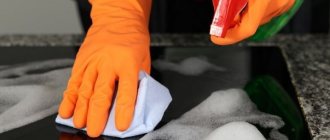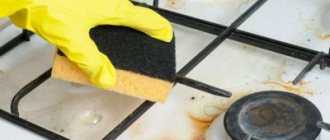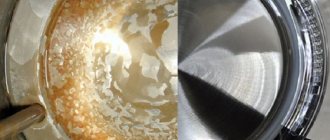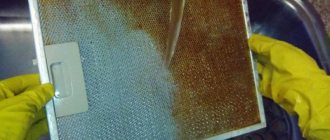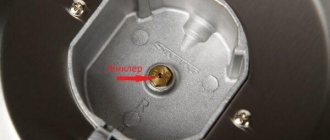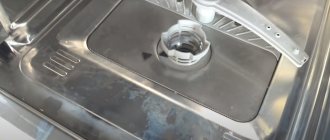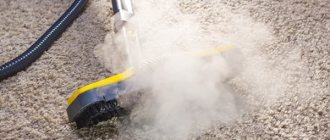Special attention is paid to the kitchen stove, because cooking, frying and almost all other thermal processing of food occurs thanks to this technique. Due to the high load, it becomes dirty very quickly: the remains of burnt food, escaped milk, dust, oil, greasy deposits - this is only a small part of everything that accumulates on the surface of the unit. Cleaning a gas stove is not so difficult; it is enough to know several methods by which getting rid of grease and carbon deposits at home will be no more difficult than brushing dust off the shelves.
Features of surface cleaning
Before proceeding directly to the procedure for cleaning the gas stove, you should find out what material was used for the coating, and choose detergents depending on it. The body and surface can be made of enameled metal or stainless steel.
Each of them has features that need to be taken into account when selecting care and cleaning agents. Removable parts should also be washed from greasy traces - handles, burners, grates, burners. Let's take a closer look at each type of coating.
Enameled
Enameled slabs are widely available and are the most popular type. Housewives choose it for such advantages as:
- wear resistance;
- durability;
- unpretentiousness;
- large selection of models in different shades;
- corrosion resistance;
- low price.
Cleaning this coating is not difficult, but there are a number of features. It is “afraid” of mechanical damage – a dent or chip cannot be removed. Enameled coating will not last as long as stainless steel.
To clean enamel, you can use any household chemicals for washing kitchen surfaces; the main rule is not to use aggressive, abrasive substances, as well as hard brushes and sponges. They can scratch the enamel, which will ruin the appearance, in addition, dirt will stick more strongly. The only powdered substance that can be used is baking soda, as it has a gentle effect on dirt without harming the coating.
Attention! Do not leave active compounds on the stove for a long time; the maximum allowed time is 30 minutes.
Many hypermarkets and specialized household chemical stores sell various enamel cleaning products, so purchasing them will be a plus.
Made of stainless steel
This species is also quite popular, for good reason. Stainless steel:
- unpretentious in care;
- wear-resistant;
- elegant;
- has a stylish design;
- looks expensive;
- has a long service life;
- not afraid of chips and dents.
However, even the slightest water stain is noticeable on stainless steel. So that it does not lose its attractiveness and shine, it is necessary to constantly wipe it. Such a surface, like an enameled one, does not tolerate hard sponges or abrasives; as damage occurs, the shine is lost.
It is better to clean a stainless steel stove with soft rags or sponges; you should choose gel or spray products. After finishing the washing procedure, carefully wipe the coating with a clean cotton cloth or paper towel so that no streaks remain. Traces of detergent and drops of water can be removed with glass washing liquid.
Professional chemistry against grease and carbon deposits
Household chemicals suitable for caring for gas appliances are available in the form of liquids, gels, sprays and powder. Should be used with caution, strictly following the manufacturer's instructions. The five popular household chemicals are as follows.
- Eco liquid Synergetic for cleaning ovens and stoves. For economical consumption of the composition, the bottle is equipped with a dispenser. Price from 200 rubles.
- The alkaline composition of Sanita in the form of a gel and spray is good at removing greasy deposits from surfaces of any type. It has no pungent odor. Price 100-200 rubles.
- “Oven Cleaner”, Amway is a fairly expensive gel. Positioned as an effective, environmentally friendly and harmless product. Used for cleaning ovens and hobs. Price from 500 rubles.
- Bagi Schumanit gels, powders and sprays are available for cleaning different types of surfaces. It has a pungent odor. The price is affordable, 200-400 rubles.
- Universal composition Cif for daily care. It is odorless and effectively removes grease stains. Price from 150 rubles.
Regular maintenance of a gas stove not only gives the device an aesthetic appearance, but also has a positive effect on the quality of operation of the equipment and extends its service life.
In general, cleaning the gas stove grate and the entire device does not take much time if you do everything correctly and use proven products. Now you know exactly how to clean the grate on your gas stove, oven and other appliance parts.
Preparation
Before cleaning your gas stove, prepare the surface. There are several recommendations to follow:
- First of all, you need to turn off the gas supply - close the valve on the gas pipe. This will help avoid leakage.
- Check that the surface to be cleaned has cooled down. Under no circumstances should you start cleaning if the gas stove is still hot or warm: there is a risk of getting burned and also damaging the equipment.
- Next, you should prepare the detergents that will be used. You should not mix them with each other - the result will be unpredictable.
- We must not forget about protection: aggressive household chemicals and their fumes are dangerous for the delicate skin of the hands and mucous membranes; some substances leave burns. Therefore, it is better to protect your hands with long, thick household gloves, and your respiratory tract with a medical mask.
- Afterwards, remove the dishes and all removable parts from the surface. First we remove the grates, then the burners. It is also advisable to unscrew the gas supply control knobs; it wouldn’t hurt to wash them either.
- Remove food residues that can be removed without the use of additional products.
- If you have planned general cleaning, move from top to bottom - first you should clean the surface of the stove itself, then the handles and outer walls, and lastly the oven.
When the preparation of the workplace is completed, you can safely proceed to the main stage of cleansing.
Folk remedies
Everything you need to properly clean enamel or stainless steel coatings is always at hand: in the kitchen or in your home medicine cabinet. The only thing worth paying attention to is the compatibility of the active ingredient with the material.
Vinegar
Using table vinegar, you can clean the stove from strong old dirt that is difficult to remove by other means.
It is necessary to pour the acid into a spray bottle and spray it on the surface that needs to be washed off old grease and carbon deposits. If you don't have a spray bottle, carefully pour a small amount of solution directly onto the dirt. Leave for 20-25 minutes, after which the gas stove can be cleaned with a sponge.
Soda
Baking soda is a very necessary tool in the kitchen, because it is universal in both cooking and cleaning. It is suitable for cleaning both enamel and stainless steel - its particles do not scratch the surface.
If the grease stains are fresh, you can remove them like this:
- Apply a small amount of baking soda to a soft sponge.
- Rub the stained area.
- Wash off any remaining fat with warm water.
If the carbon deposits and grease are quite old and ingrained, you need to do the following:
- Pour 100 g of baking soda into a small deep bowl.
- Add a little water to it to make a thick paste.
- Spread the resulting mixture over the contaminated areas with a soft sponge and rub in lightly.
- After half an hour, rinse off the cleaning agent with a cloth soaked in clean water.
- Wipe with a dry cloth.
Vinegar + soda
This method is very effective, because acid and alkali enhance each other’s effects. After using this composition, kitchen surfaces will sparkle.
To clean a dirty gas stove at home, you must follow these steps:
- Pour a little 9% vinegar onto the stains.
- Sprinkle baking soda on top of the same areas.
- When the reaction is over, use a sponge to wash off the grease and carbon deposits.
- Rinse off the solution with clean warm water.
- Wipe the remaining liquid dry with a soft towel.
Lemon acid
This substance is known to housewives, as it works well on various types of contaminants, including adhering fat and carbon deposits.
10-15 g of lemon must be diluted in 250 ml of water, pour the resulting liquid into a spray bottle and spray on the coating. After half an hour, clean the stove with a dry cloth. If you don’t have acid on hand, you can take lemon juice or lemon (wipe half the fruit directly onto the particles of stuck food, and then rinse them with water).
Ammonia
Ammonia is actively used not only in medicine, but also in the household.
1 tsp. ammonia must be dissolved in 250 ml of water, wipe the stove, wait about 15 minutes, wash off the dirt. If the coating is enameled, it can be cleaned with a medium-hard brush, but for cleaning stainless steel, the hard side of the sponge is suitable, the main thing is not to overdo it, rub gently and carefully.
Attention! Ammonia has a very pungent odor, so before washing off the stuck-on fat, you need to ventilate the room and put on a protective mask. After the cleaning procedure, you also need to open the windows to allow air to enter the room.
Soap + soda
You can remove carbon deposits from the stove using liquid soap, baking soda and water mixed in equal quantities. The resulting mixture must be applied to the coating, cleaned off the grease, left for 10 minutes, then rinsed with clean water, and wiped dry with a soft cloth.
Soda + glue + powder
This method is suitable if the gas stove is very dirty and it is almost impossible to clean it in other ways. The ingredients in the recipe will cope with the soot, you just need to put in a little effort.
You can clean your gas stove from grease as follows:
- 1 tbsp. l. soda ash, the same amount of silicate glue, 150 g of any washing powder, 250 ml of clean water must be mixed in a small bowl so that a homogeneous mass is obtained.
- Apply the mixture on the stove for half an hour.
- After this time, clean the softened food debris with a damp sponge.
Laundry soap
This is perhaps one of the simplest methods that allows you to quickly clean the stove and dishes from old carbon and grease with a minimum of effort. Fatty acids and alkalis contained in laundry soap dissolve dirt particles, which makes it easy to remove. It also has antibacterial properties, which is a plus, especially when cleaning the kitchen.
You need to grate a quarter of a bar of soap on a fine grater, then add a little water to the shavings until a thick paste forms. Apply it to contaminated areas, after 10-15 minutes wash with the hard side of a sponge or toothbrush.
Mustard
Our grandmothers and great-grandmothers also used mustard to wash away greasy stains, because it dissolves such contaminants well.
Pour a small amount of mustard powder into a deep plate, add a little water to make a homogeneous thick paste. Then distribute the resulting mass, wait 20-30 minutes, clean the gas surface from grease with a soft sponge, and rinse with clean water.
Activated carbon
Crush 10-20 tablets of activated carbon into powder, add water to them to form a semi-liquid mass. Then you need to apply it to enamel or stainless steel, after 30-40 minutes clean it with a cloth, wash off the dirt, and remove any remaining active substance with a dry towel.
Cleaning the handles
Many device owners admit that it is very difficult to clean the handles of a gas stove, but at the same time a large amount of dirt always accumulates on them. Dirt usually accumulates in the most difficult to reach places, so we should talk about cleaning handles in more detail.
Many people are interested in the question of how to remove the handles? They should be removed following the instructions for the stove - as a rule, it says how to do this (if such a possibility exists at all).
The removable handles can be washed in the same way as the grill: by placing them in a container filled with a solution of laundry soap and leaving them for 30-40 minutes. After soaking, it will be much easier to remove the softened dirt. For the same purposes, it is quite possible to use vinegar essence, a couple of tablespoons of which dissolve in a liter jar of water. You need to wear gloves to use this cleanser so as not to damage the skin of your hands. The handles are boiled in the essence solution for 5-7 minutes, then the water is drained. Wait for the handles to dry naturally and screw them back on.
Unfortunately, not all models of household stoves are equipped with removable handles; in this case, other auxiliary items and tools are suitable, for example:
- toothpicks and cotton swabs;
- hard toothbrush;
- baking soda or soda ash;
- ammonia.
Each area to be cleaned must be treated with a damp sponge on which soda has been applied; usually even old stains are removed the first time, but if we are talking about hard-to-reach places, you will have to use cotton swabs soaked in a solution of ammonia.
How to clean handles and burners?
Handles and burners do not get dirty as quickly as the area under the grates, but they also get greasy splashes. These elements are often not given due attention; contaminants accumulate and become increasingly difficult to wash.
All removable elements should be cleaned separately, but the methods are practically the same. Washing them is usually a little easier, unless, of course, the stains are long-term. Vinegar, soda, and ammonia can easily remove grease and carbon deposits on your handles.
Soap solution
This method is suitable for small, fresh, oily marks. You need to rub a quarter of a piece of laundry soap in 1 liter of water, put the stove parts in the liquid for half an hour, then rinse them in clean water and wipe with a dry cloth.
If the burners are not very dirty, you need to wipe them with a dry cloth and check if the holes are clogged. If necessary, clean them with a pin.
How to clean burners
Burners, as a rule, do not suffer from contamination as much as other elements of the stove, but this does not mean that their cleanliness should not be monitored. During general cleaning of the stove, do not forget to remove the burners, wipe them with a damp cloth, then wipe them dry and make sure that all openings are clean. If clogged, they can be carefully cleaned with a needle, pin or straightened paper clip.
Special means
In addition to folk remedies, you can also use household chemicals. It removes dirt faster and more effectively, but is not suitable for allergy sufferers. In addition, professional substances are often very aggressive towards human skin, so it is worth observing safety precautions.
Special products will help you clean gas and electric stoves:
- CIF Power&shine. Great for cleaning any stove top, including glass-ceramic.
- Mr. Muscle "Citrus Energy". This product can be used to clean kitchen surfaces and plumbing fixtures.
- Cillit Bang allows you to wash off many types of stains, including greasy ones.
- Electrolux e6scc106 will help remove grease and carbon deposits from stainless steel.
- Comet. The gel-like product removes dirt from any kitchen surface.
How to quickly clean a burnt stove
How to clean a stove if it is very dirty and burnt? A potent combination composition will come to the rescue. To remove stains and carbon deposits, combine:
- 250 g of clean water at room temperature;
- 1 large spoon of silicate stationery glue;
- 30 grams household soap, which needs to be grated (can be replaced with powder);
- 3 spoons of baking soda.
After mixing thoroughly, the composition should be applied to the dirty area and left for a couple of hours, then rinsed off.
By the way, this product allows you to wash the stove without streaks. Judging by the experience of housewives, this composition is ideal even for stainless steel models.
To clean a burnt oven, many people use a combination of salt and carbonic acid. You need to take 0.5 liters of water, 1 kilogram of salt and a small amount of carbonic acid. This composition is sent to a baking sheet and placed at the very bottom of the oven, then heated at a temperature of 140 degrees for 30 minutes. When the oven has cooled, clean it with a sponge and cleaner. Contaminants should come off as easily as possible. The unpleasant smell will also go away.
You don’t have time to clean the kitchen yourself, but still want to enjoy cleanliness and freshness? Are you worried that you will damage the coating of your hob while cleaning? The cleaning company's specialists will take care of putting things in order in the kitchen. During cleaning, hypoallergenic organic compounds are used, which not only cope with dirt, but also provide an antibacterial effect. The result is the desired purity and no risks to your health.
Tips for care and use
In order for a gas stove to serve for many months and delight you with its cleanliness, you should follow the rules for caring for equipment:
- Clean regularly. Fresh grease stains will be much easier to clean off than old carbon deposits.
- Do not neglect the use of lids - this way much less splashes of oil and food particles will get on the coating.
- When cooking, do not move far from the stove, make sure that the food does not “run away”.
- The gas stove can be covered with foil and changed when it gets dirty. This way the coating will always remain clean.
Burner covers
We're done with the grates, it's time for the burners. Let's start with the simplest thing - lids. If they are not very dirty, you can easily clean them with regular wet wipes.
If the burner lids are not very dirty, you can easily clean them with ordinary paper napkins
Dirt cannot be wiped off, but there is a layer of greasy soot on the inside of the lid? Yes, you can’t handle this with napkins. And with a soap solution - easily. Dissolve laundry soap in hot water and leave the lids there for a while. And then wipe thoroughly with a sponge and dry. That's all the concern.
